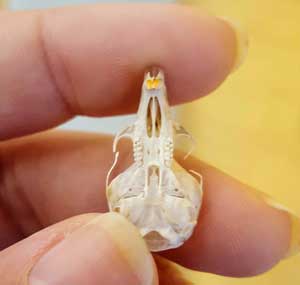The Jasper Ridge Site is an archaeological deposit that was excavated in the 1980s by Dr. Barbara Bocek, then a graduate student at Stanford herself. Jasper Ridge is part of the aboriginal homeland of the Muwekma Ohlone Tribe. Dr. Bocek was studying the diets of the Ohlone people who called the site home about 1000 years ago. She was able to use the animal remains from the site to figure out what the inhabitants ate. But there were still boxes of sediment (i.e. dirt) from her initial dig which had not yet been analyzed stored in the Stanford University Archaeological Collections.
The sediment was basically the waste from the site — dirt, rocks, bits of charcoal, and tiny fragments of shell and bone. Yet the archaeologists had preserved every bit of it for the possible use of future researchers (like Liz did with her pellets). Every box had multiple bags inside, which were meticulously labeled with information about where in the site and how deep in the earth they’d been collected. The boxes had been gathering dust for a couple of decades, but to me they were a gold mine. It took me months of work, but I was eventually able to sort out hundreds of small mammal teeth and bones from these boxes. I hoped that these bones would be able to tell me what the small mammal community of Jasper Ridge looked like 1000 years ago.

Analyzing the very smallest material from the site revealed species that hadn’t been discovered in the original analysis. For example, I discovered deer mice (Peromyscus sp.) were present at the site by identifying their miniscule teeth in the sediments. Small mammals such as deer mice may have been an important part of the small mammal community, but were not the focus of the previous study. That’s because the original researchers concentrated on animals large enough to comprise a significant portion of the native population’s diet. I, on the other hand, was interested in identifying all the small mammal species that made this site a home — no matter how small. And although some of these small mammals may have been hunted and eaten by the people living at this site, it’s unlikely that they were worth tracking and hunting far away from their residence like they would do with larger animals, such as deer. This means that, unlike with the larger mammals from this archaeological deposit, small mammal remains are likely representative of their local community composition — which is exactly what I was interested in!
I now had an understanding of what the local small mammal community looked like at Jasper Ridge when the native Ohlone ancestors lived there. After correcting for some biases, such as excluding small mammals physically too large to be eaten by a barn owl, I compared the modern and ancient communities of Jasper Ridge. In addition to including an invasive species, Rattus rattus, the modern community was distinct in having a much higher prevalence of voles and other grassland specialists. Perhaps this is because grasslands at Jasper Ridge have expanded over time, in part due to human modification of the environment. However, to get at the larger picture of human impact on small mammal communities in the Bay Area, I needed to compare across more sites.
Since I already had plenty of modern data, what I now needed was to add more archaeological sites. I hoped to use these additional archaeological sites to understand how small mammal communities distributed themselves across space in the past. How different were pre-European small mammal communities across regions of the Bay Area? Were they more or less different across the local landscape than today?
With more data, I could potentially assess which drivers (or causes) best explain the difference in small mammal communities across the landscape today versus in pre-European times. These drivers could include habitat type, geographical distance, or human impact, and may be distinct between the past and present. My previous study suggested that today human impacts drive differences between sites. Would this still be the case further back in time, before urbanization?
